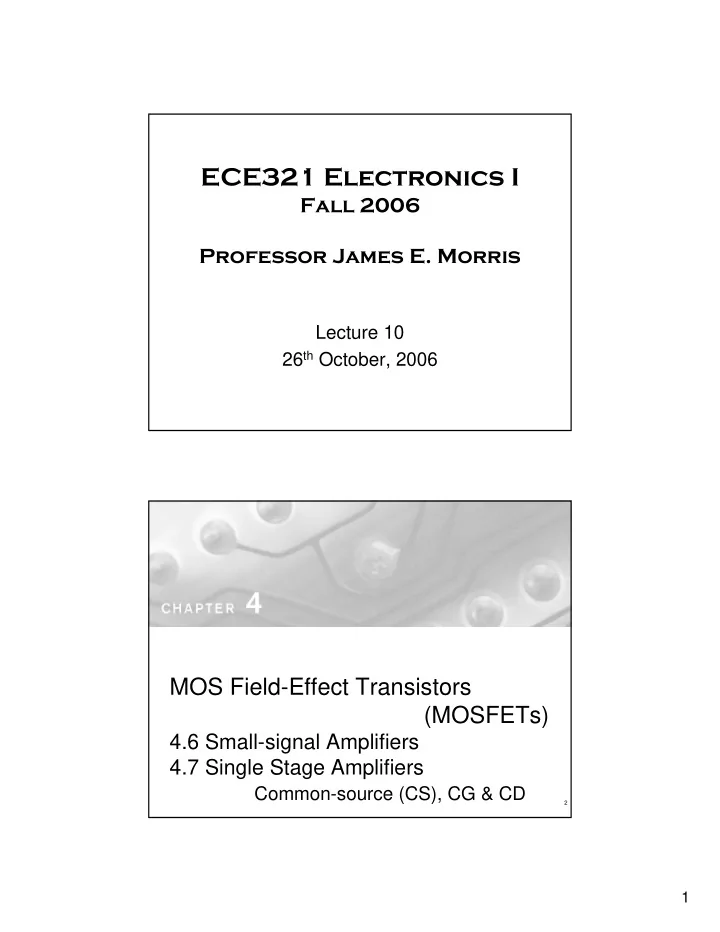

ECE321 Electronics I Fall 2006 Professor James E. Morris Lecture 10 26 th October, 2006 MOS Field-Effect Transistors (MOSFETs) 4.6 Small-signal Amplifiers 4.7 Single Stage Amplifiers Common-source (CS), CG & CD 2 1
Figure 4.34 Conceptual circuit utilized to study the operation of the MOSFET as a small-signal amplifier. Figure 4.35 Small-signal operation of the enhancement MOSFET amplifier. 2
Figure 4.34 Conceptual circuit utilized to study the operation of the MOSFET as a small-signal amplifier. Figure 4.36 Total instantaneous voltages v GS and v D for the circuit in Fig. 4.34. 3
Figure 4.37 Small-signal models for the MOSFET: (a) neglecting the dependence of i D on v DS in saturation (the channel-length modulation effect); and (b) including the effect of channel-length modulation, modeled by output resistance r o = | V A | / I D . Figure 4.38 Example 4.10: (a) amplifier circuit; (b) equivalent-circuit model. 4
Figure 4.39 Development of the T equivalent-circuit model for the MOSFET. For simplicity, r o has been omitted but can be added between D and S in the T model of (d) . Figure 4.40 (a) The T model of the MOSFET augmented with the drain-to-source resistance r o . (b) An alternative representation of the T model. 5
Figure 4.41 Small-signal equivalent-circuit model of a MOSFET in which the source is not connected to the body. Table 4.2 6
Figure 4.42 Basic structure of the circuit used to realize single-stage discrete-circuit MOS amplifier configurations. Figure E4.30 7
Figure 4.43 (a) Common-source amplifier based on the circuit of Fig. 4.42. (b) Equivalent circuit of the amplifier for small-signal analysis. (c) Small-signal analysis performed directly on the amplifier circuit with the MOSFET model implicitly utilized. Figure 4.44 (a) Common-source amplifier with a resistance R S in the source lead. (b) Small-signal equivalent circuit with r o neglected. 8
Figure 4.42 Basic structure of the circuit used to realize single-stage discrete-circuit MOS amplifier configurations. Figure 4.45 (a) A common-gate amplifier based on the circuit of Fig. 4.42. (b) A small-signal equivalent circuit of the amplifier in (a). (c) The common-gate amplifier fed with a current-signal input. 9
Figure 4.46 (a) A common-drain or source-follower amplifier. (b) Small-signal equivalent-circuit model. (c) Small-signal analysis performed directly on the circuit. (d) Circuit for determining the output resistance R out of the source follower. Table 4.4 10
Table 4.4 (Continued) Table 4.3 11
Recommend
More recommend